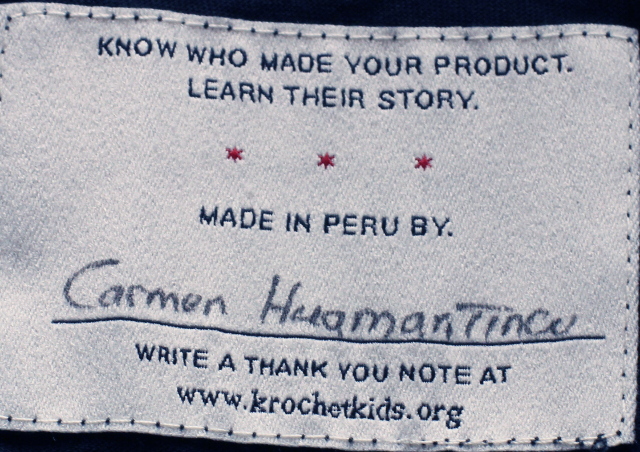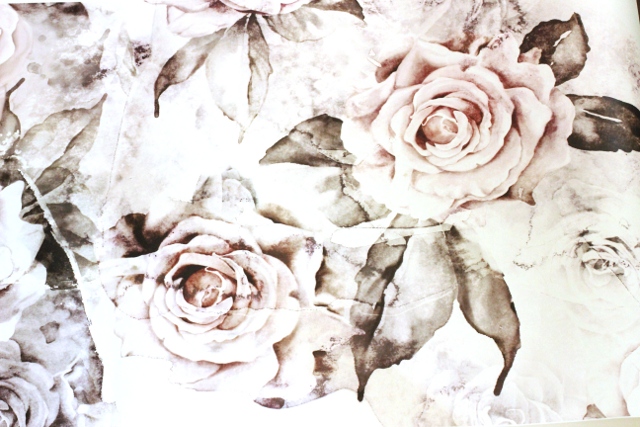
(Carmen Huamantico made my top.)
Yesterday I told you about Fashion Revolution and the movement to bring awareness and responsibility to our clothing purchases, in an effort to prevent more tragic accidents from occurring. Today is Inside Out Day, and you are encouraged to wear an item of clothing inside out, with the tag showing, so people will know where your clothing came from. It’s a way to remember the factory collapse in Dhaka, Bangladesh and the thousands who were injured and killed one year ago today.
Recently, I was chatting with my sister about fair trade clothing, and she asked where she should start. When I became interested in fair trade and ethical clothing, I basically searched online for information about where to shop. Everyone has a different opinion about how to remove yourself from the cycle of fast fashion, and I’ll share a few things I’ve learned in the past year that have worked for me. It does take a bit of legwork and a change of habit, but once you know where to shop and what to look for, it’s easy to shop ethically and responsibly on a regular basis.
Shop locally: If you’re able to patronize local boutiques and small stores, you’ll find many items made by local designers where you live. Look for basic items like tops and jewelry that are made in your city. You’ll be supporting your local economy and local artists, too.
Thrift and consignment stores: I’m the first to admit that I didn’t grow up thrifting, and there can be a little bit of an ick factor involved when shopping for used clothing. Local consignment stores are a great place to start, and since they have high acceptance standards, you’ll find clothing in great condition. Goodwill can also be a great place to go for basics like jeans and skirts. And I’ve already told you about ThredUp, an online consignment store that has a wonderful selection. When you purchase previously owned clothing, you aren’t exchanging money for new goods. It’s a way to make clothing last longer.
Etsy, Instagram, and Blogger Shops: Etsy has always been a great place to find unique, handmade fashion, and now lots of people are selling new and used items on Instagram, too. You can find bloggers selling items from their closet for a fraction of the price. And don’t forget eBay, either. Many bloggers also have their own online stores, selling vintage like Platinum and Rust and Bloomers and Frocks, and handmade items from Mexico can be found at Mitla Moda, where Dus gives 100% of the profits back to the communities that produced them.
Fair Trade stores: Online fair trade stores have really taken off in recent years, and some of my favorites are Mata Traders, Fair Indigo, VavaVida, Raven and Lily, and Passion Lilie, all of which I’ve written about in the past. Certified fair trade items are made under strict standards that ensure workplace safety and fair wages for workers and artisans in other countries. In many cases, the employees are taught skills that will help them earn a living wage for the rest of their lives. I like to give fair trade items as gifts as a way to share the idea with others.
American-made brands: Most items are made overseas now, but you can still find brands that are made in the United States. I prefer to patronize stores that make their products domestically because I know that their workers are paid fairly and work in safe conditions. Many small businesses and designers make their goods in the United States, and it’s a wondeful way to strengthen our economy, too. Some of my favorites include Artifact Bags, American Apparel, and Everlane. Some of Everlane’s products are made in other countries, but they are in direct contact with the manufacturers and visit the factories often.
Do your research: Like my recent experience with the Anthropologie catalog, it can be difficult to tell what items are actually made where. Imported is usually code for China, and all clothing is required to be labeled with its country of origin. When you get a catalog in the mail, notice the country listed after the item name. Try to buy items made in the United States, if you can. Search your favorite site for domestically made items. Also, take the time to visit your favorite store’s website and look for the About or Our Story page, sometimes located at the bottom of the site. It will give you a good indication of a company’s ethics and will sometimes mention their social responsibility, too. When all else fails, ask. Email your favorite store and ask them where their products come from. It never hurts to ask, and you’ll be raising awareness at the same time. I have found many domestic and even fair trade items at mainstream stores including Anthropologie, Ruche, and ModCloth.
Avoid temptation: If you love shopping, it can be difficult to break old habits as you try to build new ones. Don’t visit stores that sell fast fashion, and you’ll be less tempted to buy it. When you receive clothing coupons and catalogs in the mail, recycle them right away. Delete sale emails before you open them or unsubscribe from mailing lists altogether. Out of sight, out of mind really helps here, and you won’t be tempted to shop sales at Target and Kohl’s if you don’t know about them in the first place.
Think before you buy: Don’t shop in a hurry and don’t make last minute decisions. If you do your research and give yourself time, you can save money to buy better-made, responsible pieces that will last longer. Wear what you already have and make the best use of it. When you are done with an item, donate or consign it.
It takes a bit of practice and determination, but just like with any lifestyle change, shopping responsibly will benefit you (and others) in so many ways. I hope you find these suggestions helpful and please feel free to offer your own ways to shop more responsibly.
Remember this scene from The Devil Wears Prada? I always think about it when it comes right down to fashion, because we really do have a choice. If Miranda Priestly and the people in that room are the top tier of the fashion industry, then the people who make our clothes are at the bottom.
“You think this has nothing to do with you.”
Last year on April 24th, when the Rana Plaza factory collapsed in Bangladesh, 1,133 people were killed and over 2,500 seriously injured. Those numbers are staggering, and inside the factory, labels were found from stores including Cato, The Children’s Place, and Mango, among others. The people inside were making our clothes. The clothes that are sold at inexpensive prices in mid-level stores across the United States.
“That blue represents millions of dollars and countless jobs.”
I was at the beginning of my ethical clothing journey the day that building collapsed a world away, and one picture in particular opened my eyes to the atrocities taking place in the fast fashion industry. I won’t place the photo on my blog, since it isn’t mine and it’s quite disturbing, but here’s a link if you want to see what I saw, and it is graphic. The purpose of that photo is not to shock, but to show you what happens when we look the other way.
“You think you’ve made a choice that exempts you from the fashion industry.”
I don’t know if that man and woman were husband and wife, brother and sister, or maybe cousins or friends. Perhaps they were co-workers or even strangers who clung to each other in a moment of terror and desperation. They died in darkness, in fear, and undoubtedly, in pain, and their lives were worth more than the thrill of a $9.99 t-shirt. They have to be.
I once read that shopping is like voting with your money, and as consumers, we do have a voice. We can tell our favorite stores and brands that inexpensive clothing shouldn’t kill those who make it, that they deserve to work safely, with regular hours and fair pay for the work that they do. That man and that woman were just like you and me, with families to care for and basic needs they had to meet, and they found work where they could and were trying to get by, just like we all are.
Tomorrow marks one year since the Rana collapse, and it’s a day to reflect on our choices as consumers. Fashion Revolution is asking you to take a moment to consider where your clothing comes from, to wear it inside out to show the tag, and to remember that someone, somewhere, made that shirt or blouse or dress that covers your back. That touches your skin. That hides your nakedness.
Fashion is wonderful. It’s a way to show our individuality and express our creativity. But it’s not worth dying for, and it shouldn’t have to be.
If you’re interested in learning more about the situation in Bangladesh, I can highly recommend this story. Hopefully these photos and facts will encourage you to make small changes that can greatly impact the lives of others for the better. There were many survivors of the factory collapse, and they are trying to rebuild their lives.
And this short film beautifully demonstrates the stories that go into each piece of clothing we wear.
I hope you’ll stop by tomorrow when I’ll be sharing easy ways to start shopping more responsibly.


(My sample of Rose Decay wallpaper by Ellie Cashman Design.)
So I’m really, really late to the party, and it’s something I thought I’d never do, but if you look over there on the right, you’ll see my new Pinterest link. I snubbed that site for years, in the interest of creativity and privacy, but last week, partly due to the full moon and Ryan working late every night, I decided to bite the bullet. Plus, my bookmarks are just getting way too out of control these days.
Call me a hypocrite, but I’ve found myself perusing the site quite frequently lately. You don’t technically have to be a member to do searches and look at pictures, so I would sometimes wander over before I got my hair cut, when I was looking for ways to decorate with a blue couch, or when I decided to stop coloring my hair. It turns out there’s quite a bit of grey inspiration on Pinterest. And a lot of my favorite bloggers no longer post five days a week, so I’ve started checking out Instagram and Pinterest as a way to see a little bit more from them.
I know lots of people think blogs are past their prime, and bloggers have moved to other forms of social media to share their opinions and influence. I think that’s true in a lot of ways, but for me, at least, Pinterest will just be for my own inspiration. At first, I made all of my boards private, but as I added pictures here and there with the click of a button, I decided I should return the favor and share my inspiration, too. I also added a few boards with my own photos, and I’m sure I’ll add more as I go.
So that’s that. No balloons or streamers or anything. I just thought I’d tell you that I finally jumped on the bandwagon, so feel free to follow me and I’ll gladly follow you back.
